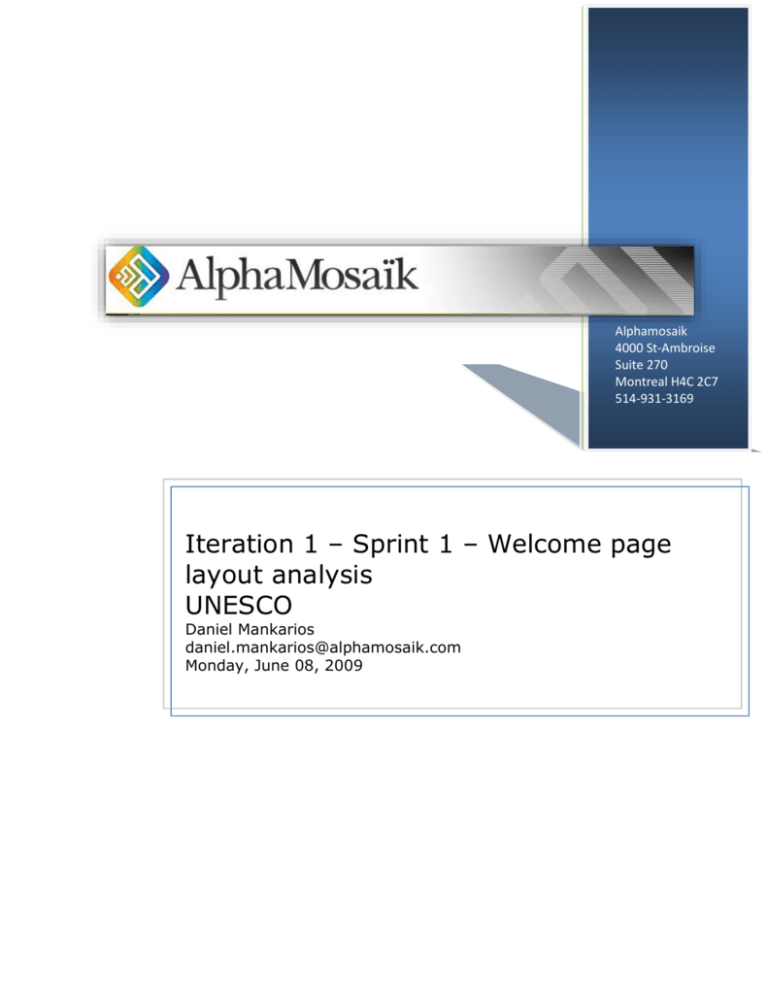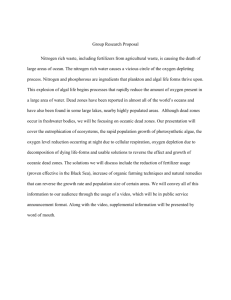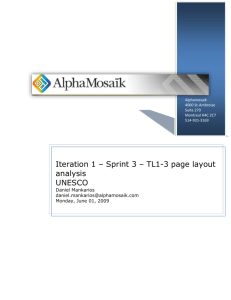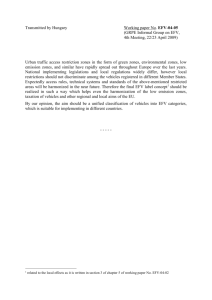Iteration 1 * Sprint 1 * Welcome page layout analysis
advertisement

Alphamosaik 4000 St-Ambroise Suite 270 Montreal H4C 2C7 514-931-3169 Iteration 1 – Sprint 1 – Welcome page layout analysis UNESCO Daniel Mankarios daniel.mankarios@alphamosaik.com Monday, June 08, 2009 Friday, May 22, 2009 Page 2 TABLE OF CONTENTS 1. 2. Description of the mandate ..................................................................... 3 1.1. Introduction .................................................................................... 3 1.2. Document subject and scope ............................................................. 3 1.3. References ...................................................................................... 4 1.4. Acronyms and Definitions .................................................................. 4 Action Plan............................................................................................ 5 2.1. Preliminary introduction to SharePoint content ..................................... 5 2.1.1. Publishing HTML Field Controls ..................................................... 5 2.1.2. Web part zones .......................................................................... 5 2.1.3. Other zones ............................................................................... 6 2.2. Analysis .......................................................................................... 7 2.2.1. Due to make a difference............................................................. 8 2.2.2. Direct Access – Data Center ......................................................... 8 2.2.3. Direct Access – Documentation Library .......................................... 9 2.2.4. What’s New ............................................................................... 9 2.2.5. Featured Content...................................................................... 10 2.3. Summary ...................................................................................... 11 2.4. Conclusion .................................................................................... 11 2 Friday, May 22, 2009 Page 3 Document history Author : Daniel Mankarios daniel.mankarios@alphamosaik.com 514-931-3169 x178 Reviewer(s) Name Name Name Name E-mail Your e-mail Your e-mail Your e-mail Date Date Date Date Document status Draft 1. Description of the mandate 1.1. Introduction The UNESCO Institute for Statistics (UIS) wishes to create a new public web site using a renovated look and a more alluring interface. The platform selected is Microsoft Office SharePoint 2007. The website will be using AlphaMosaik's multilingual module as well as several custom components to deliver a rich experience to all future users of their site. 1.2. Document subject and scope This document will cover one particular page layout within the SharePoint site. This page layout is the « Welcome Page » and is used in only one location: the home page. The discussions in this document pertain to the analysis of the nature of the actual zones found on the page and the sources of content for these zones (within the page or from a container within the site). The elements of the master page (top zone above and including the yellow banner, grey menu zone at the left) are excluded from this analysis as they are not part of the content zone. 3 Friday, May 22, 2009 Page 4 1.3. References 1. Microsoft. (2009). ASP.NET Web Parts Overview. Retrieved May 22, 2009, from http://msdn.microsoft.com/en-us/library/hhy9ewf1.aspx 1.4. Acronym WSS WFE SQL AD MOSS BLOB IIS SP TL1 TL2 TL3 CEWP CQWP Acronyms and Definitions Definition Windows SharePoint Services v3.0 Web-Front-End Structured Query Language Active Directory Microsoft Office SharePoint Server 2007 Binary Large Object Internet Information Services Service Pack Theme Level 1 Theme Level 2 Theme Level 3 Content Editor Web Part Content Query Web Part Static content: All references to static content within this document refer to content that is entered directly into a zone designated to receive text that does not change frequently. For example, the description of a theme on the theme welcome page is considered to be static. Dynamic content: All references to dynamic content within this document refer to content that is not directly entered into a zone designated to receive text, but rather to content that is automatically pulled from a container (list or library) whose content can change frequently or automatically based on dynamic filters (date filters and such). 4 Friday, May 22, 2009 Page 5 2. Action Plan 2.1. Preliminary introduction to SharePoint content This section will help UNESCO understand the nature of the various zones available in a SharePoint site and the implications each zone has for editing and approval. 2.1.1. Publishing HTML Field Controls SharePoint allows the placing of publishing HTML field controls within a page. These controls exist as zones and take on a certain position and size within the page. They are also rich text enabled, allowing editors to customize text to their liking. A certain number of predefined styles will be available (based on the design material provided by Akufen) so that editors may ensure uniformity across all HTML field control zones. However, a certain number of the rich text controls will also be disabled to prevent overriding the styles. The image below provides a preview of the HTML field control zone (with the styles dropdown showing). This type of zone is considered to be a static content zone. Modifications to the content of this zone are performed directly in the page where the zone is located. The zone cannot be relocated as it is an integral element of the layout (the layout can be modified by an administrator with the appropriate tools and permissions). 2.1.2. Web part zones Web part zones are zones in which web parts are added. The following image illustrates a webpart zone, which has similar properties to a HTML field control zone in its static placement and size on the page, and the dialog allowing users to add web parts to the zone. Web parts are defined in the following manner: ASP.NET Web Parts is an integrated set of controls for creating Web sites that enable end users to modify the content, appearance, and behavior of Web pages directly from a browser. (Microsoft, 2009) 5 Friday, May 22, 2009 Page 6 The web parts to be used will pull content from containers within the site where the page is located. These containers will be lists or libraries of various sorts. Since the content of the list can change independently from the page itself, web parts are generally considered to be dynamic content objects. The following image illustrates 3 sample web parts in their zone (edit mode) as well as the final appearance for an end user: As the content gets pulled from containers throughout the site, editing of the content displayed in the webpart is performed inside the containers (lists, libraries) where the content is located. This is the native behavior of SharePoint and should be understood by UNESCO content editors and approvers. 2.1.3. Other zones Other publishing zones do exist (image zones, title zones, other field controls) but will not be used for the design of the welcome page layout. Therefore, their descriptions are excluded from this document. 6 Friday, May 22, 2009 Page 7 2.2. Analysis The analysis is to be conducted on the content zone of the welcome page. The mockups provided by UNESCO will be used to refer to the various zones on the page with each subsection of the document describing a different zone on the page. The content zone referred to above is the represented in the following diagram: 7 Friday, May 22, 2009 Page 8 2.2.1. Due to make a difference This zone will contain static text and will be implemented using a publishing HTML field control. 2.2.2. Direct Access – Data Center This zone will contain a set of hyperlinks and some text. As the content of this zone will rarely change, it can be implemented using a publishing HTML field control. However, since its graphical appearance is consistent with a number of other components in the site (title colors, font, and background), it is best implemented with a versatile webpart: the Content Editor Web Part (CEWP). This webpart allows the insertion of rich text content (HTML) in the very same manner as an HTML field zone. The differences are that it is packaged in a webpart (can inherit the styles applied to web parts) and that the webpart or zone can have a fixed height (to ensure proper alignment with its neighboring webpart). Should it be too difficult to control the styles and appearance of this component using a CEWP, it can be implemented using a “Summary links web part” with appropriate styling and layout. 8 Friday, May 22, 2009 Page 9 2.2.3. Direct Access – Documentation Library The same reasoning as the “Data Center” zone applies to this zone. It will be implemented using a Content Editor Web Part. 2.2.4. What’s New Title Image Body Link This zone will contain a listing of recent news (i.e. dynamic content). Therefore it will consist of a webpart whose behavior and design is described in a separate document (Iteration 1 – Sprint 1 - What’s New Webpart and derivatives analysis). The most likely candidate for this webpart would be a Content Query Webpart (CQWP). 9 Friday, May 22, 2009 Page 10 2.2.5. Featured Content This zone contains a mix of different content, each item published under a different heading. Given the nature of the content (“featured”), it can be considered to be dynamic. Additionally, given the formatting constraints (optional image at a certain position, heading positions, fonts, sizes, links, etc.), this zone would be best implemented using a webpart that will automatically format the content using a set of predefined rules. The most likely candidate for this webpart would again be the CQWP. 10 Friday, May 22, 2009 Page 11 2.3. Summary The various zones of content in the welcome page can be summarized with the following mockup: 2.4. Conclusion To conclude, the welcome page layout described in the above paragraphs should address the needs of UNESCO based on the preliminary analysis provided in the RFP and the discussions with UNESCO. 11





